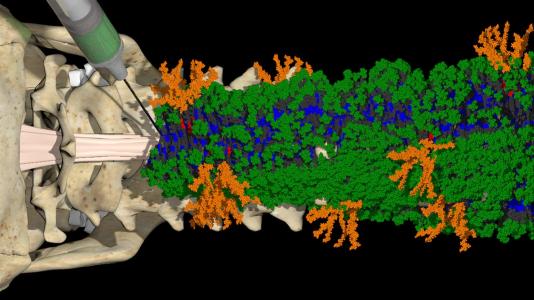
Researchers have developed an injectable treatment that uses ‘dancing molecules’ to repair spinal injuries. Four weeks after a single injection, paralyzed mice were able to walk again. The research team used the Advanced Photon Source (APS) at Argonne National Laboratory to confirm their breakthrough, which offers hope to thousands paralyzed with severe spinal cord injuries each year.
For decades, scientists have looked for an effective treatment for spinal cord injuries, often with little success. Now, new research by Northwestern University scientists has resulted in a game-changing innovation: an injection that uses ‘dancing molecules’ to repair spinal tissue and reverse paralysis.
The treatment has already been shown to work in mice. Paralyzed mice regained their ability to walk four weeks after an injection of the new treatment. The research, recently published in the journal Science, offers hope to thousands of people who are paralyzed with severe spinal cord injuries every year.
A critical portion of this research was conducted at the Advanced Photon Source (APS), a U.S. Department of Energy (DOE) Office of Science user facility at DOE’s Argonne National Laboratory. There, scientists used ultrabright X-ray beams to study the structure of the engineered molecules and how they behaved together in a solution.
Argonne National Laboratory seeks solutions to pressing national problems in science and technology. The nation’s first national laboratory, Argonne conducts leading-edge basic and applied scientific research in virtually every scientific discipline. Argonne researchers work closely with researchers from hundreds of companies, universities, and federal, state and municipal agencies to help them solve their specific problems, advance America’s scientific leadership and prepare the nation for a better future. With employees from more than 60 nations, Argonne is managed by UChicago Argonne, LLC for the U.S. Department of Energy’s Office of Science.
The U.S. Department of Energy’s Office of Science is the single largest supporter of basic research in the physical sciences in the United States and is working to address some of the most pressing challenges of our time. For more information, visit https://energy.gov/science.